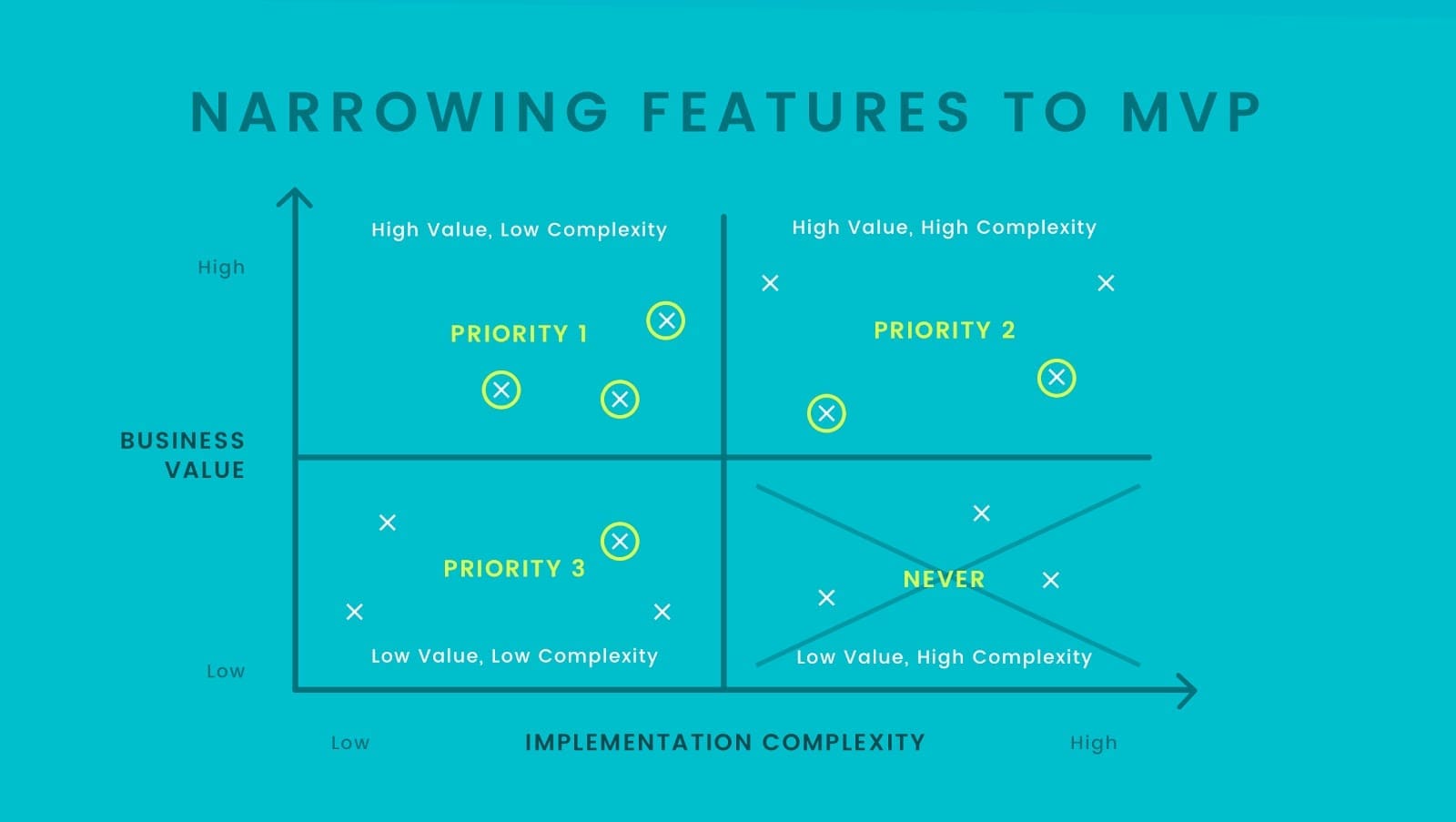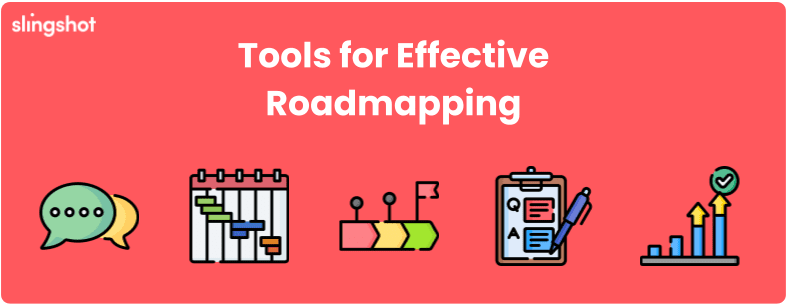Every CIO and tech leader grapples with creating a practical IT roadmap. It’s like navigating through a maze at a music festival: no idea where you’re going and so. much. noise!
The tech landscape is loud, fast-paced, and constantly changing. So, how do you cut through the noise and zero in on what really matters? Buckle up because we’ll take you on a journey to simplify and supercharge your roadmap planning. We’ll discuss identifying good ideas, narrowing them down to your best ones, and setting yourself up for tech success!
Summary
- Brainstorming and Filtering Ideas: Gather ideas from stakeholders and market trends, then narrow them down using critical criteria.
- Prioritizing with Value vs Complexity Chart: Use this tool to focus on initiatives that offer the most value with the most minor complexity.
- User Testing and Validation: Validate your ideas with real users through surveys, prototypes, and A/B testing.
- Assessing Feasibility and Competitive Analysis: Evaluate technical feasibility and understand your market to identify opportunities.
- Building and Adapting Your Roadmap: Select the top initiatives, use project management tools, and continuously adapt your roadmap to stay relevant.
1) Identifying Potential Ideas
First things first, let’s get those creative juices flowing!
Brainstorming and Research
Start with brainstorming sessions involving your key stakeholders. The more diverse the group, the better the pool of ideas. Don’t just stick to your IT folks; bring in people from marketing, sales, and customer support. They’ll have unique perspectives that can spark innovative solutions.
Source of Ideas
Look both internally and externally for inspiration. Internally, gather suggestions from your team. Externally, keep an eye on industry trends and what your competitors are up to. A blend of these perspectives will give you a well-rounded view of potential opportunities. Most importantly, solicit feedback and ideas from those who use your product.
2) Analyzing and Filtering Ideas
Now, you’ve probably got a ton of ideas. Great! But how do you decide which ones are worth pursuing?
Initial Analysis
Start with a broad analysis. During this phase, there’s no idea that’s too wild; don’t say no to something just because it ‘feels’ wrong. Evaluate each suggestion based on a few critical metrics (which we will talk about right now ⬇️)
Criteria for Filtering
When filtering ideas, focus on critical criteria that work best for your organization. No two companies should evaluate using the same metrics, but some examples could be alignment with business goals, evaluation of the potential ROI, and consideration of the initiative’s strategic importance.
3) Value vs Complexity Chart
Here’s a nifty tool to help you: the Value vs Complexity chart.
What is it?
The Value vs Complexity chart is a visual aid that helps prioritize initiatives based on their expected value and implementation complexity. On one axis, you have the value it brings to the business, and on the other, the difficulty of implementing it. You’ll plot each idea on the chart to see where it fits best. Doing this effectively often requires collaboration between business and technology resources. You’ll want to have tech resources giving you feedback on overall complexity. Below is an example:

Interpreting the Chart
The chart ends up having four quadrants. Ideas high in value but low in complexity are your sweet spots; we’ll label those Priority 1. Then we have the maybes: High Value, High Complexity, or Low Value, Low Complexity. You’ll want to tackle some of these but not all. Finally, those high in complexity but low in value aren’t your best bet.
4) User Testing – Concept Validation
So, you’ve filtered down your ideas. Now, let’s validate with the people who need them.
Conducting User Tests
User testing is crucial. You need to know if your ideas resonate with the people who’ll use them.
Use interviews, prototypes, and A/B testing. And remember, don’t just ask if they like the idea. Instead, dig deeper: ask about the problem the idea aims to solve. Is it a problem worth solving? Is there a better solution you’re not thinking of? With a new feature idea, you’ll get better feedback if you show users a visual representation of how the feature will work. Simple wireframes often work well for this.
Incorporating Feedback
Take the feedback seriously and refine your ideas based on real user insights. Some ideas only need minor tweaking to align with user needs, while others may need to be reevaluated entirely and scrapped.
5) Assessing Technical Feasibility
Your ideas have been charted and user-tested—time to see if they’re technically feasible.
Technical Evaluation
Assessing each idea’s technical aspects is essential. This step goes beyond the high-level complexity we mention in the chart above. You’ll want to evaluate the features, platforms, and tools necessary to get the job done. How doable is all that with your current tech stack and resources?
Collaboration with Development Teams
Get your development teams involved early. Having the team that will eventually build it evaluate complexity and timeline helps ensure your estimates are accurate. They’ll know best what the potential challenges and resource requirements are.
6) Competitive Analysis
It’s not just you you need to worry about; keep your friends close and your competitors closer.
Understanding the Market
Analyzing your competitors’ strategies is crucial to better understanding their efforts. What’s working? What isn’t? This deep dive not only helps you avoid failed ideas but also allows you to tap into their weaknesses and capitalize on opportunities with proven market fit.

Identifying Gaps and Opportunities
Look for gaps in the market. These can be your opportunities to innovate and gain a competitive edge. But the grass isn’t always greener; consider why it might be a gap. It could mean it’s incredibly challenging to solve that problem, or it isn’t big enough.
Benchmarking
Numbers, numbers, numbers. Benchmark against your competitors and the market to set realistic goals and expectations. Realistic is the key here: you don’t want to under-sell a good idea, but you don’t want to overestimate success.
7) Evaluating Long-Term Value and Alignment
It’s more than just users, technical issues, or your competitors. You need to think long-term, beyond the immediate gains.
Strategic Fit
Evaluate your ideas to determine how well they align with your company’s values. Consider how each idea could contribute to your long-term objectives and if it aligns with your mission.
Sustainability and Scalability
Consider whether your team can maintain the initiative over the long term. Will your team need to grow? Will the project be scalable long-term? How much of your budget will you need to keep things moving?
8) Final Selection: The Worthy Projects
And now, we’ve all been waiting for the decision.
Narrowing Down
When refining your list of ideas to actual projects, strive to pick up to five key initiatives. It’s hard to map out farther than that, so don’t put extra work on yourself. If you initially have fewer than ten ideas, reduce the list by half (for example, if you have eight ideas, select the top four initiatives).
Justification
Provide a detailed explanation for your choices. Don’t just say it “felt” like the best option. Explain why you think these initiatives are the top choices. Use a clear and comprehensive framework to justify your selections, and include a hypothesis for each initiative.
For instance, “We believe that by implementing this feature, we’ll achieve this outcome… and we’ll know we’ve succeeded by observing these metrics.” This method will help you refer back to your justifications later if any roadblocks come up, and it will also help you measure the success of each initiative effectively.
Timing
When you’re planning your projects, it’s crucial to balance long-term and short-term goals. Annual roadmaps give you a big-picture view of your strategic direction, while quarterly roadmaps break it down into a more detailed and doable plan. The quarterly approach gives you more flexibility and agility, so you can adjust and fine-tune your priorities every few months. By combining both annual and quarterly roadmaps, you can make sure your strategy stays cohesive and stays responsive to changing circumstances and market conditions.
Roadmapping the Final
Outline the steps you’ll need to do to incorporate these initiatives into a coherent and actionable roadmap. These steps should include identifying key stakeholders, establishing clear timelines and benchmarks, allocating necessary resources, and aligning the initiatives with overarching organizational goals and strategies. Additionally, it’s essential to consider potential challenges and their mitigation strategies and mechanisms for ongoing monitoring.
9) Tools for Effective Roadmapping
Before heading off on this road trip, let’s ensure we have the right tools in the trunk!

Project Management Tools
Managing your project roadmap is crucial for keeping everything on track. Project management tools such as Jira, Asana, or Trello can help you plan, organize, and schedule tasks and milestones. These tools offer features like task assignment, progress tracking, and timeline visualization, which are all essential for long-term project management.
Roadmapping Software
Consider using specialized road mapping tools like Aha!, Roadmunk, and ProductPlan to help you create detailed roadmaps. These tools provide features explicitly tailored for roadmap planning, which can help get you on the right track.
Collaboration Platforms
Communication is key! Consider utilizing platforms like Slack or Microsoft Teams to ensure everyone’s informed and engaged. Effective communication is essential for successful roadmap management. Keep all team members in the loop to ensure everyone is on the same page.
10) Continuous Evaluation and Adaptation
Don’t set it and forget it; your roadmap should live and breathe!
Monitoring Progress
It’s essential to monitor your projects and tasks as they are completed consistently. Are you meeting the milestones and deadlines that you’ve set for yourself? If not, devise a game plan to fix this.
Iterative Improvement
Remember to continuously review and adjust your strategic plan in response to new information and evolving requirements. Stay flexible and be prepared to pivot to align with your goals and the current business landscape.
Conclusion
Every CIO and tech leader grapples with creating a practical IT roadmap. We’ve taken you on a journey to simplify and supercharge your roadmap planning. From brainstorming sessions to filtering ideas through critical criteria, we’ve shown you how to focus on the initiatives that genuinely matter. You’ve learned to use charts, user feedback, technical feasibility, and competitive analysis to effectively prioritize and validate your ideas.
With your top initiatives selected, you can build a clear, actionable roadmap using the best tools available. Remember, your roadmap is a living document that should be continuously adapted to keep up with the ever-evolving tech landscape.
Applying these strategies can create an IT roadmap that cuts through the noise and drives your business forward. Stay focused, agile, and ready to pivot when necessary. Happy planning, and here’s to your tech success!
Want More Roadmapping Content?

Written by: Savannah Cherry
Savannah is our one-woman marketing department. She posts, writes, and creates all things Slingshot. While she may not be making software for you, she does have a minor in Computer Information Systems. We’d call her the opposite of a procrastinator: she can’t rest until all her work is done. She loves playing her switch and meal-prepping.

Edited by: Chris Howard
Chris has been in the technology space for over 20 years, including being Slingshot’s CIO since 2017. He specializes in lean UX design, technology leadership, and new tech with a focus on AI. He’s currently involved in several AI-focused projects within Slingshot.




